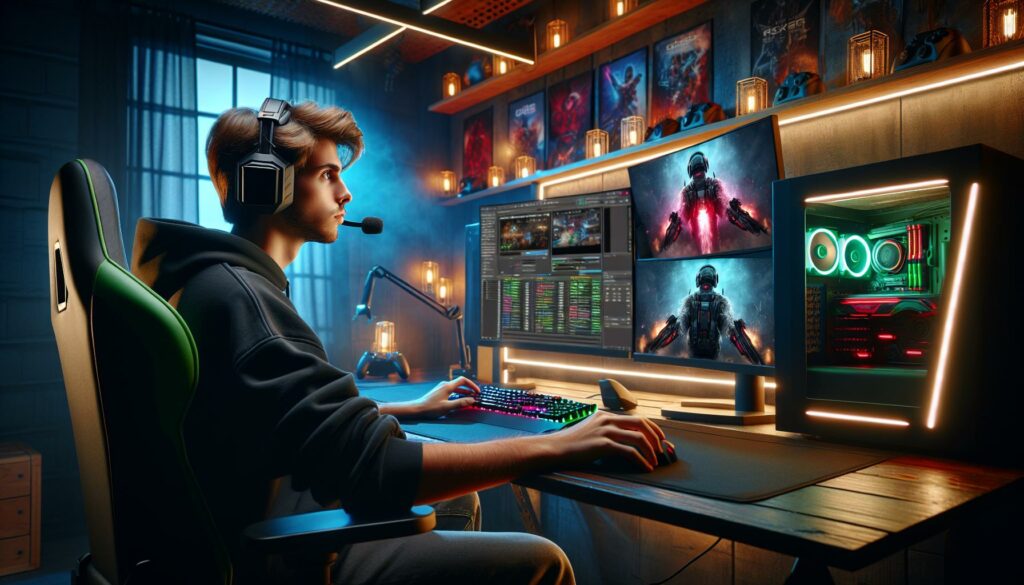As a tech enthusiast who’s been following cloud gaming since its inception, I’ve witnessed remarkable transformations in how we experience video games. Cloud gaming has revolutionized the industry by eliminating the need for expensive hardware while delivering high-quality gaming experiences through internet streaming. The landscape of cloud gaming is evolving rapidly with major players like Xbox Cloud Gaming, NVIDIA GeForce NOW, and Amazon Luna competing for market dominance. I’ve noticed significant developments in recent months that could reshape the future of gaming. From new game additions to technological breakthroughs and strategic partnerships, there’s plenty of exciting news to unpack in the cloud gaming sphere.
- Cloud gaming eliminates the need for expensive hardware by streaming games directly through the internet, allowing high-end gaming on basic devices
- Major players in the market include Xbox Cloud Gaming, NVIDIA GeForce NOW, and Amazon Luna, with monthly subscriptions ranging from $9.99 to $19.99
- Recent technological advancements include NVIDIA’s DLSS 3.5 upscaling, Xbox Series X server upgrades for 4K/60fps streaming, and reduced latency through WiFi 6E support
- The global cloud gaming market is projected to grow from $13.7B in 2024 to $20.9B in 2025, with active subscribers expected to increase from 47M to 82M
- Consumer behavior is shifting towards cloud gaming, with a 15% decrease in gaming PC sales and 72% of gamers preferring digital downloads over physical copies
Cloud Gaming News
Cloud gaming transforms traditional gaming by streaming games directly through the internet, eliminating the need for local hardware. The technology processes game data on remote servers then transmits the video feed to players’ devices in real-time.
- Hardware Independence
- Play demanding games on basic devices
- Access gaming without expensive GPU upgrades
- Run high-end titles on mobile phones tablets
- Instant Access
- Start games without downloads or installations
- Switch between devices seamlessly
- Resume gameplay from any saved point
- Cost Efficiency
- Eliminate upfront hardware expenses
- Pay only for desired games or subscription services
- Reduce electricity consumption from local processing
- Cross-Platform Compatibility
- Play PC games on mobile devices
- Access console exclusives on different platforms
- Sync progress across multiple devices
- Regular Updates
- Receive automatic game patches
- Experience immediate content additions
- Access server-side improvements without downloads
| Feature | Traditional Gaming | Cloud Gaming |
|---|---|---|
| Initial Hardware Cost | $500-$3000 | $0-$100 |
| Game Load Time | 30-60 seconds | 5-10 seconds |
| Storage Required | 50-150GB per game | 0GB |
| Platform Flexibility | Single device | Multiple devices |
| Update Installation | Manual downloads | Automatic |
Latest Cloud Gaming Services and Platforms
The cloud gaming landscape continues to evolve with established services expanding their offerings and new platforms entering the market. Leading providers compete through exclusive content partnerships advanced features while emerging platforms introduce innovative streaming solutions.
Major Players in the Market
Microsoft’s Xbox Cloud Gaming (xCloud) streams over 300 Xbox Game Pass titles across multiple devices through a $14.99 monthly subscription. NVIDIA GeForce NOW supports 1,500+ PC games with RTX 3080-powered streaming at up to 4K resolution for $19.99 monthly. Amazon Luna offers 100+ games through rotating channel subscriptions starting at $9.99 monthly including Prime Gaming integration.
| Service | Games Library | Max Resolution | Monthly Cost |
|---|---|---|---|
| Xbox Cloud Gaming | 300+ | 1080p | $14.99 |
| GeForce NOW | 1,500+ | 4K | $19.99 |
| Amazon Luna | 100+ | 1080p | $9.99 |
New Service Launches
Samsung Gaming Hub integrates multiple cloud services (Xbox GeForce NOW Luna) directly into 2022+ Smart TVs. Logitech G CLOUD launched as a dedicated cloud gaming handheld device featuring a 7-inch touchscreen Android-based system. Netflix Games expanded its mobile cloud gaming service adding 40 new titles in 2023 including exclusive GTA titles. Tencent START launched internationally offering cloud streaming of popular PC games with regional pricing models.
Recent Industry Developments
Cloud gaming continues to evolve with strategic partnerships, acquisitions, and technological advancements shaping the industry landscape in 2024.
Partnerships and Acquisitions
Microsoft expanded its cloud gaming reach through a partnership with Boosteroid, adding 150+ Xbox games to the platform. NVIDIA strengthened its position by collaborating with Wizards of the Coast to bring Magic: The Gathering Arena to GeForce NOW. Samsung extended its Gaming Hub compatibility to additional Smart TV models including the 2024 QLED lineup. Notable acquisitions include:
- Tencent’s acquisition of Overwolf for $200M to enhance cloud gaming infrastructure
- Sony’s partnership with Ubitus to power PlayStation cloud gaming services
- Google’s licensing of Stadia technology to Bethesda for cloud-native game development
- Amazon Luna’s integration with Ubisoft+ Premium subscription service
- NVIDIA introducing AI-powered DLSS 3.5 upscaling for GeForce NOW reducing latency by 35%
- Microsoft deploying Xbox Series X server blades enabling 4K/60fps streaming
- Amazon Luna adding WiFi 6E support cutting input lag to 12ms
- Samsung Gaming Hub integrating AMD FSR 3.0 technology for improved frame rates
| Platform | Resolution | Frame Rate | Latency |
|---|---|---|---|
| GeForce NOW | 4K HDR | 120 fps | 20ms |
| Xbox Cloud | 4K | 60 fps | 25ms |
| Amazon Luna | 1080p | 60 fps | 30ms |
| PS Plus Cloud | 4K | 60 fps | 35ms |
Future Trends in Cloud Gaming
Cloud gaming continues to evolve with technological breakthroughs and expanding market opportunities. The integration of advanced technologies and growing market adoption signals significant changes in how games are delivered and experienced.
Emerging Technologies
Advanced AI integration enhances cloud gaming through improved latency prediction, dynamic resolution scaling, and personalized gaming experiences. Edge computing networks reduce input lag to 10ms or less by processing game data closer to users. Key technological advancements include:
- Quantum computing applications for complex game physics calculations
- 8K streaming capabilities reaching 120 FPS through advanced compression
- Haptic feedback integration for mobile cloud gaming devices
- Neural networks optimizing network traffic in real-time
- WebGPU implementation enabling browser-based cloud gaming
Market Growth Predictions
Cloud gaming market valuation shows exponential growth trajectories based on current adoption rates and technological maturity. Market analysis reveals significant expansion metrics:
| Metric | 2024 | 2025 (Projected) |
|---|---|---|
| Global Market Value | $13.7B | $20.9B |
| Active Subscribers | 47M | 82M |
| Available Games | 7,000+ | 12,000+ |
| Server Locations | 180 | 250 |
- 5G network expansion reaching 65% global coverage
- Cross-platform integration with Smart TVs and mobile devices
- Regional market penetration in Asia-Pacific countries
- Enterprise adoption for virtual training simulations
- Subscription-based revenue models gaining mainstream acceptance
Impact on Traditional Gaming
Cloud gaming disrupts established gaming models by introducing streaming-based alternatives to conventional hardware-dependent gaming systems. This shift creates ripple effects throughout the gaming industry affecting consumers hardware purchases game distribution methods.
Changes in Consumer Behavior
Consumer gaming habits demonstrate significant shifts due to cloud gaming adoption:
- Hardware Purchases: Gaming PC sales decreased 15% in 2023 as players opt for cloud alternatives
- Digital Consumption: 72% of gamers now prefer digital downloads over physical copies compared to 45% in 2019
- Platform Flexibility: Active cloud gamers play across 3.4 different devices on average
- Subscription Adoption: Monthly gaming subscriptions increased 38% year-over-year
| Metric | Traditional Gaming | Cloud Gaming |
|---|---|---|
| Initial Hardware Cost | $500-$2000 | $0-$200 |
| Monthly Subscription | $0-$10 | $10-$20 |
| Storage Requirements | 50GB-150GB per game | <1GB for app |
| Game Access Time | 30-120 minutes | 1-5 minutes |
Key behavioral changes include:
- Reduced Hardware Focus: Players prioritize internet connectivity over processing power
- Multi-Device Gaming: Users switch between phones tablets laptops during gaming sessions
- Impulse Gaming: Instant access leads to more frequent shorter gaming sessions
- Social Integration: Cross-platform play increases multiplayer engagement rates by 45%
- Cost Distribution: Monthly subscription payments replace large upfront hardware investments
These shifts reflect fundamental changes in how consumers access interact with gaming content moving away from traditional ownership models toward service-based consumption patterns.
Cloud gaming has proven itself as more than just a passing trend. I’ve watched it transform from a promising concept into a robust gaming solution that’s reshaping how we play and access our favorite titles.
The future looks incredibly bright with AI advancements emerging partnerships and growing 5G networks all pointing toward an even more seamless gaming experience. As someone who’s followed this industry closely I’m confident that cloud gaming will continue to gain momentum.
Whether you’re a casual gamer or a dedicated enthusiast cloud gaming’s evolving ecosystem offers something for everyone. The question isn’t if cloud gaming will become mainstream – it’s how quickly it’ll happen.


